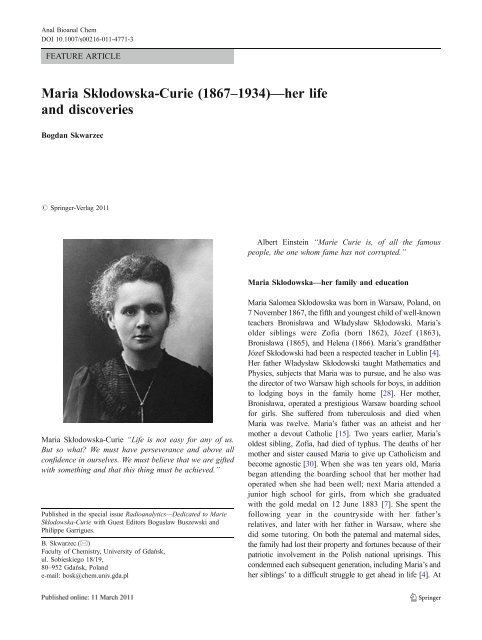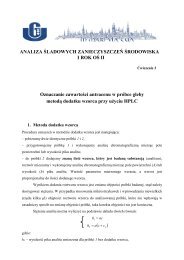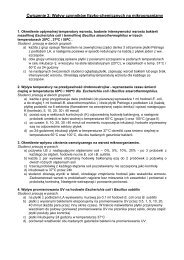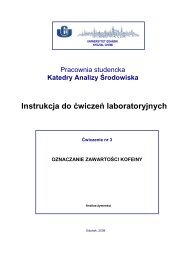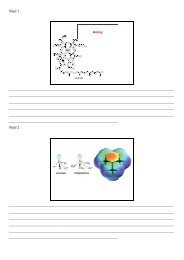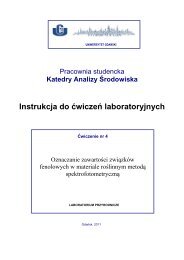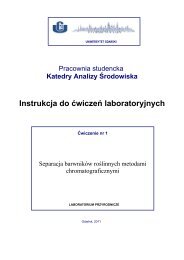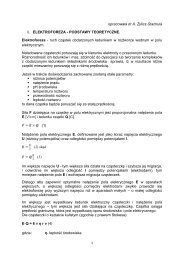Maria Skłodowska-Curie (1867–1934)—her life and discoveries
Maria Skłodowska-Curie (1867–1934)—her life and discoveries
Maria Skłodowska-Curie (1867–1934)—her life and discoveries
You also want an ePaper? Increase the reach of your titles
YUMPU automatically turns print PDFs into web optimized ePapers that Google loves.
SWM (Schweizer Waffen Magazin) 12/2009
<strong>Maria</strong> <strong>Skłodowska</strong>-<strong>Curie</strong> (<strong>1867–1934</strong>)power. He demonstrated that this radiation, unlike phosphorescence,did not depend on an external source ofenergy, but seemed to arise spontaneously from uraniumitself [1–3]. Becquerel himself made specific observations,for instance that gases through which the rays passedbecame conductors of electricity, but he soon left this field.Becquerel had, in fact, discovered radioactivity but<strong>Skłodowska</strong>–<strong>Curie</strong> decided to look into uranium rays as apossible field of research for a thesis. She used a clevertechnique to investigate samples. Fifteen years earlier, herhusb<strong>and</strong> Pierre <strong>and</strong> his brother Jacques had invented theelectrometer, a sensitive device for measuring electricalcharges. Using the <strong>Curie</strong> electrometer, she discovered thatthorium gives off the same rays as uranium <strong>and</strong> uraniumrays caused the air around a sample to conduct electricity[7]. Using this technique, her first discovery was that theactivity of uranium compounds depended only on thequantity of uranium present. She had shown that radiationwas not the outcome of some interaction of molecules, butmust come from an atom itself. In scientific terms, this wasthe most important single piece of work that she conducted[30]. <strong>Skłodowska</strong>–<strong>Curie</strong>’s systematic studies had includedtwo uranium minerals, pitchblende <strong>and</strong> torbernite (alsoknown as chalcolite). Her electrometer showed thatpitchblende was four times as active as uranium itself,<strong>and</strong> chalcolite twice as active [4]. She concluded that, if herearlier results relating the quantity of uranium to its activitywere correct, then these two minerals must contain smallquantities of some other substance that was far more activethan uranium itself [37]. The idea (writes [30]) was herown; no one helped her formulate it, <strong>and</strong> although she tookit to her husb<strong>and</strong> for his opinion she clearly established herownership of it. She later recorded the fact twice in herbiography of her husb<strong>and</strong>, to ensure there was no chancewhatsoever of any ambiguity [7]. It is likely that already atthis early stage of her career she realized that manyscientists would find it difficult to believe that a womancould be capable of original work in the field in which shewas involved [30]. In her systematic search for othersubstances beside uranium salts that emitted radiation,<strong>Skłodowska</strong>–<strong>Curie</strong> found that the element thorium, likewise,was radioactive. She was acutely aware of theimportance of promptly publishing her <strong>discoveries</strong> <strong>and</strong> thusestablishing her primacy [34]. Had not Becquerel, twoyears earlier, presented his discovery to the Académie desSciences, the day after he made it, the credit for thediscovery of radioactivity, <strong>and</strong> even the Nobel Prize, wouldhave gone to Silvanus Thompson (Professor of Physics atthe City <strong>and</strong> Guilds Technical College in Finsbury, UK.Thompson repeated Röntgen’s experiments on the day afterthe discovery was announced in the UK <strong>and</strong> subsequentlygave the first public demonstration of the new rays at theClinical Society of London on 30 March 1896) instead.<strong>Skłodowska</strong>–<strong>Curie</strong> chose the same rapid means of publication.Her paper, giving a brief <strong>and</strong> simple account of herwork, was presented for her to the Académie on 12 April1898 by her former professor, Gabriel Lippmann [7, 37].Even so, just as S. Thompson had been beaten byBecquerel, so was <strong>Skłodowska</strong>–<strong>Curie</strong> in the race topublicize her discovery that thorium gives off rays in thesame way as uranium. Three weeks earlier, GerhardSchmidt had published his own findings in Berlin [31].At that time, however, no one else in the world ofPhysics had noticed what <strong>Skłodowska</strong>–<strong>Curie</strong> recorded inher paper, her description of how much greater theactivities of pitchblende <strong>and</strong> chalcolite were than that ofuranium itself: “The fact is very remarkable, <strong>and</strong> leads tothe belief that these minerals may contain an elementwhich is much more active than uranium.” She laterwould recall how she felt “a passionate desire to verifythis hypothesis as rapidly as possible” [4, 30]. Pierre<strong>Curie</strong> was sure that what she had discovered was not just aspontaneous effect. He was so intrigued that he decided todrop his work on crystals temporarily <strong>and</strong> to join her inher research. On 14 April 1898, they optimisticallyweighed out a 100 gram sample of pitchblende <strong>and</strong>ground it with a pestle <strong>and</strong> mortar ([7]. They did notrealize at the time that what they had been searching forwas present in such minute quantities that they eventuallywould have to process tons of the ore [26]. They were alsounaware of the dangerous effects of radiation exposure intheir work with radioactive substances; <strong>Skłodowska</strong>–<strong>Curie</strong><strong>and</strong> her husb<strong>and</strong> had no idea what price they would paydue to the effect of their research on their health [4].Polonium <strong>and</strong> radium <strong>discoveries</strong><strong>Maria</strong> <strong>and</strong> Pierre <strong>Curie</strong> continued systematic chemicalanalysis studies of uranium ores <strong>and</strong> discovered thatstrong activity came with the fraction containing bismuthor barium [25, 27]. When <strong>Maria</strong> continued her analysis ofthe bismuth fractions, she found that every time shemanaged to take away an amount of bismuth, a residuewith greater activity was left. At the end of June 1898,they had a substance that was about 300 times more activethan uranium [7]. In their work published on July 18,<strong>Skłodowska</strong>-<strong>Curie</strong> <strong>and</strong> her husb<strong>and</strong> Pierre wrote: “Wethus believe that the substance that we have extracted frompitchblende contains a metal never known before, akin tobismuth in its analytic properties. If the existence of thisnew metal is confirmed, we suggest that it should be calledpolonium after the name of the country of origin of one ofus” [9, 37]. She discussed the radioactive nature of poloniumin the paper <strong>and</strong> concluded that radioactivity is materialemission [32]. After another few months of work, on 26
B. SkwarzecDecember 1898, the <strong>Curie</strong>s <strong>and</strong> Bémont announced theexistence of another element, which they named “radium”for its intense radioactivity— a word that they coined [10].The discovery of radium was confirmed by spectroscopicanalysis of barium chloride salt [13]. Pitchblende is acomplex mineral <strong>and</strong> the chemical separation of its constituentswas an arduous task. The discovery of polonium hadbeen relatively easy; chemically it resembles the elementbismuth, <strong>and</strong> polonium was the only bismuth-like substance inthe ore. Radium, however, was more elusive [7]. It is closelyrelated, chemically, to barium, <strong>and</strong> pitchblende contains bothelements. By 1898–1899 <strong>Maria</strong> <strong>Skłodowska</strong>-<strong>Curie</strong> hadobtained traces of radium, but appreciable quantities, uncontaminatedwith barium, still were beyond reach [35]. Insubsequent years she undertook the arduous task of separatingradium salt by differential crystallization [16, 17]. From a tonof pitchblende, one-tenth of a gram of radium chloride wasseparated in 1902 [18]. In an unusual decision, <strong>Maria</strong><strong>Skłodowska</strong>–<strong>Curie</strong> intentionally refrained from patentingthe radium-isolation process, so that the scientific communitycould do research unhindered [30]. Henri Becquereldiscovered radiation, but the discovery of radium initiatedscientific discussion about a new opinion on the atomicstructure. <strong>Maria</strong> <strong>and</strong> Pierre <strong>Curie</strong> formulated a hypothesisabout the atomic transformation of polonium <strong>and</strong> radium <strong>and</strong>reached the conclusion that the ability to radiate did notdepend on the arrangement of atoms in a molecule [11, 12,16]. <strong>Maria</strong> drew the conclusion that it must be linked to theinterior of the atom itself; this discovery was absolutelyrevolutionary [15].<strong>Maria</strong>’s doctoral thesisFrom 1900 <strong>Maria</strong> had a part-time teaching post at the ÈcoleNormale Superieur de Sevres for Girls [4]. After thous<strong>and</strong>s ofcrystallizations she finally isolated one decigram of almostpure radium chloride <strong>and</strong> had determined radium’s atomicweight as 225. She presented the finding of this work in herdoctoral thesis. On 25 of June 1903, under the supervision ofHenri Becquerel, <strong>Maria</strong> was awarded her DSc from theUniversity of Paris for her thesis entitled “Recherches sur lessubstances radioactives” [28].The examination committee: Gabriel Lippmann, HenriMoissan, <strong>and</strong> Edmond Bouty, expressed the opinion thatthe findings represented the greatest scientific contributionever made in a doctoral thesis [4].Radiological health problem<strong>Maria</strong> <strong>and</strong> Pierre <strong>Curie</strong> were invited to the Royal Institution inLondon, <strong>and</strong> Pierre, before the crowded auditorium, showedhow radium rapidly affected photographic plates wrapped inpaper, how the substance gave off heat; in the semi-darknesshe demonstrated the spectacular light effect. He describedmedical tests which involved wrapping a sample of radiumsalts in a thin rubber covering which he had bound to his armfor ten hours. He then studied the resulting wound, which dayby day increasingly came to resemble a burn. After 52 days, apermanent grey scar appeared. Pierre realized the possibilityof radium being used in the treatment of cancers. Pierre’sscarred h<strong>and</strong>s shook so much that once he happened to spill alittle of the preparation <strong>and</strong> fifty years later the presence ofradioactivity was discovered on the premises <strong>and</strong> theparticular surface had to be cleaned [4, 7].Nobel prizesIn 1903, the Royal Swedish Academy of Sciences awardedPierre <strong>Curie</strong>, <strong>Maria</strong> <strong>Curie</strong>, <strong>and</strong> Henri Becquerel the NobelPrize in Physics, “in recognition of the extraordinary servicesthey have rendered by their joint research on the radiationphenomena discovered by Professor Henri Becquerel [4].”<strong>Skłodowska</strong>–<strong>Curie</strong> <strong>and</strong> her husb<strong>and</strong> were unable to go toStockholm to receive the prize in person, but they shared itsfinancial proceeds with needy acquaintances, includingstudents [30]. As a result of the Nobel Prize, <strong>Maria</strong> <strong>and</strong>Pierre <strong>Curie</strong> suddenly became internationally famous. On 1October 1904, the Sorbonne gave Pierre a professorship <strong>and</strong>permitted him to establish his own laboratory, in which<strong>Skłodowska</strong>–<strong>Curie</strong> became the director of research. On 19April 1906, Pierre was killed in a street accident, he was runover by a horse-drawn wagon near the Pont Nuef in Paris[4]. <strong>Maria</strong> was devastated by the death of her husb<strong>and</strong>, shewas left alone with two daughters, Irène aged 9 <strong>and</strong> Èveaged 2. <strong>Maria</strong> noted that, as of that moment she suddenlyhad become “an incurably <strong>and</strong> wretchedly lonely person”[7]. She was appointed to succeed Pierre as the head of thelaboratory, being undoubtedly the most suitable person, <strong>and</strong>to be responsible for his teaching duties. On 13 May 1906,the Sorbonne Physics department decided to retain the chairthat had been created for Pierre <strong>Curie</strong> <strong>and</strong> they entrusted it to<strong>Skłodowska</strong>–<strong>Curie</strong> together with full authority over thelaboratory. This allowed her to emerge from Pierre’s shadow[28]. On 16 November 1908, <strong>Maria</strong> was the first woman tobecome a professor at the Sorbonne, <strong>and</strong> in her exhaustingwork regime she sought a new meaning in her <strong>life</strong> [25]. Shewent on to produce four decigrams of very pure radiumchloride <strong>and</strong> determined radium’s precise atomic weight as226,45±0.5 (now 226.025) [19]. Finally, in collaborationwith Debierne, she was able to isolate radium in the metallicform [22]. At the same time <strong>Maria</strong> prepared new methods todetermine small amounts of radium by measurement ofradon [20, 23]. On September 1910, the International
<strong>Maria</strong> <strong>Skłodowska</strong>-<strong>Curie</strong> (<strong>1867–1934</strong>)Radiological Congress in Brussels invited <strong>Maria</strong> <strong>Curie</strong> toprepare international radium st<strong>and</strong>ards. In the next year Mme<strong>Curie</strong> delivered 21.99 mg of pure radium chloride to theBureau International des Poids et Mesures in Sevres [24]. For<strong>Maria</strong> <strong>Curie</strong>, the proposal from the Radiological Congresscreated a new unit of radioactivity, the <strong>Curie</strong> (1 Ci isequilibrium with activity 1 g of radium). In 1911, <strong>Maria</strong><strong>Skłodowska</strong>-<strong>Curie</strong> was awarded the Nobel Prize in Chemistry.The citation by the Nobel Committee was, “in recognitionof her services to the advancement of Chemistry by thediscovery of the elements radium <strong>and</strong> polonium; by theisolation of radium <strong>and</strong> the study of the nature <strong>and</strong>compounds of this remarkable element” [4]. <strong>Maria</strong>’s Nobellecture on December 11 in Stockholm should be read in thelight of what she had gone through. She made it clear by herchoice of words what were unequivocally her contributions incollaboration with Pierre. She spoke of the field of researchwhich, “I have called radioactivity” <strong>and</strong> “my hypothesis thatradioactivity is an atomic property,” but without detractingfrom his contributions. She declared that she also regardedthis Prize as a tribute to Pierre <strong>Curie</strong> [7]. The Frenchgovernment funded the building of a private Radium Institute(Institut du Radium, now the Institut <strong>Curie</strong>), which was builtin 1914 <strong>and</strong> at which research in chemistry, physics, <strong>and</strong>medicine was conducted [4]).Some researchers have questioned whether <strong>Maria</strong> deservedthe Prize for Chemistry in 1911 [27]. They have claimed thatthe <strong>discoveries</strong> of radium <strong>and</strong> polonium were part of thereason for the Prize in 1903, even though this was not statedexplicitly [15]. <strong>Maria</strong> was said to have been awarded thePrize again for the same discovery, the award possibly beingan expression of sympathy for reasons that will be mentionedlater [7]. Actually, however, the citation for the Prize in 1903was worded deliberately with a view to a future Prize inChemistry. Chemists considered that the discovery <strong>and</strong>isolation of radium was the greatest event in chemistry sincethe discovery of oxygen. For the first time in history it wasshown that an element could be transmuted into anotherelement, <strong>and</strong> that revolutionized chemistry <strong>and</strong> signified anew epoch [15].<strong>Skłodowska</strong>–<strong>Curie</strong> was the first person to win or sharetwo Nobel Prizes. She is one of only two people who havebeen awarded a Nobel Prize in two different fields, theother person being Linus Pauling (for chemistry <strong>and</strong> forpeace). Two Nobel Prizes have also been awarded to JohnBardeen in Physics (1956 <strong>and</strong> 1972) <strong>and</strong> Frederick Sangerin Chemistry (1958 <strong>and</strong> 1981).Rejected by the AcademyDespite the second Nobel Prize <strong>and</strong> an invitation to the firstSolvay Conference with the world’s leading physicists,including Einstein, Poincaré, <strong>and</strong> Planck, 1911 became a darkyear in <strong>Maria</strong>’s<strong>life</strong>[15]. In two smear campaigns she was toexperience the chauvinism of the French press. The firstcampaign was started on 16 November 1910, when, in anarticle in Le Figaro, it became known that she was willing tobe nominated for election to l’Académie des Sciences [4].Examples of factors other than merit influencing election tothe academy did exist, but <strong>Maria</strong> herself <strong>and</strong> her eminentresearch colleagues seemed to have considered that with herexceptionally brilliant scientific merits, her election was aforegone conclusion. As it turned out, it was not only meritthat was the deciding factor. The dark underlying currents ofanti-Semitism, prejudice against women, xenophobia, <strong>and</strong>even anti-scientific attitudes that existed in French societycame welling up to the surface [15]. Normally the electionwas of no interest to the press. The most rabid paper was theultra-nationalistic <strong>and</strong> anti-Semitic L’Action Française,which was led by Léon Daudet, the son of the writerAlphonse Daudet. Dreyfus had obtained redress for thewrongs done to him in 1906 <strong>and</strong> had been decorated with theLegion of Honor, but in the eyes of the groups who had beenagainst him during his trial, he was still guilty, was still “theJewish traitor.” [4, 30]. The pro-Dreyfus groups who hadsupported his cause were suspect <strong>and</strong> the scientists who weresupporting <strong>Maria</strong> were among them. Jokes in bad tastealternated with outrageous accusations. It was said that in hercareer, Pierre’s research had given her a free ride. She camefrom Pol<strong>and</strong>, though admittedly she was formally a Catholicbut her name Sklodowska indicated that she might be ofJewish origin, <strong>and</strong> so on. A week before the election, analternative c<strong>and</strong>idate, Édouard Branly, was proposed. Thevote on January 23 1911 was taken in the presence ofjournalists, photographers, <strong>and</strong> hordes of the curious. Theelection took place in a tumultuous atmosphere. In the firstround <strong>Maria</strong> lost by one vote, in the second by two. In all,fifty-eight votes were cast [15]. A Nobel Prize in 1903 <strong>and</strong>support from prominent researchers such as Jean Perrin,Henri Poincaré, Paul Appell, <strong>and</strong> the permanent secretary ofthe Académie, Gaston Darboux, were not sufficient to makethe Académie open its doors. This event attracted internationalattention <strong>and</strong> indignation. It deeply wounded both<strong>Maria</strong> <strong>and</strong> indeed Édouard Branly too, himself a wellmeritedresearcher [4].The Langevin AffairHowever, <strong>Maria</strong>’s tribulations were not at an end. When, atthe beginning of November 1911, <strong>Maria</strong> went to Belgium,being invited with the world’s most eminent physicists toattend the first Solvay Conference, she received a messagethat a new campaign had started in the press. Now it was amatter of her private <strong>life</strong> <strong>and</strong> her relations with her
B. Skwarzeccolleague Paul Langevin, who had also been invited to theconference [30]. He had had marital problems for severalyears <strong>and</strong> had moved from his suburban home to a smallapartment in Paris. <strong>Maria</strong> was depicted as the reason. Bothwere described in sl<strong>and</strong>erous terms. The sc<strong>and</strong>al developeddramatically. <strong>Maria</strong> st<strong>and</strong>ing up in her own defensemanaged to force an apology from the newspaper Le Temps[15]. The same day she received word from Stockholm thatshe had been awarded the Nobel Prize in Chemistry [4].However, the very newspapers that made her a legend whenshe received the Nobel Prize in Physics in 1903, nowcompletely ignored the fact that she had been awarded thePrize in Chemistry or merely reported it in a few words onan inside page. The Langevin sc<strong>and</strong>al escalated into aserious affair that shook the university world in Paris <strong>and</strong>the French government at the highest level. Day after day<strong>Maria</strong> had to run the gauntlet in the newspapers: an alien, aPolish woman, a researcher supported by our Frenchscientists, had come <strong>and</strong> stolen an honest French woman’shusb<strong>and</strong> [15]. Henri Poincaré’s cousin, Raymond Poincaré,a senior lawyer who was to become President of France in afew years time, was engaged as advisor. But the sc<strong>and</strong>alkept up its impetus with headlines on the first pages such as“Madame <strong>Curie</strong>, can she still remain a professor at theSorbonne?” With her daughters <strong>Maria</strong> stayed at Sceauxwhere she was practically a prisoner in her own home. Thedrama culminated on the morning of 23 November whenextracts from letters were published in the newspaperL’Oeuvre [38]. There was no proof of the accusations madeagainst <strong>Maria</strong> <strong>and</strong> the authenticity of the letters could bequestioned but in the heated atmosphere there were fewwho thought clearly [14].First World WarIn 1914, <strong>Maria</strong> was in the process of beginning to lead one ofthe departments in the Radium Institute established jointly bythe University of Paris <strong>and</strong> the Pasteur Institute. In August1914, Germany invaded France <strong>and</strong> <strong>Maria</strong> took her twodaughters, Irène aged 17 <strong>and</strong> Ève aged 10, to Brittany forsafety. She had another reason for her journey—with her wentaheavy,20kgleadcontainerinwhichshehadplacedhervaluable radium, which she left there before returning toBordeaux [15]. During the war <strong>Maria</strong>, with the help of herdaughter Irène, pushed for the use of mobile radiographyunits, which came to be popularly known as petites <strong>Curie</strong>s(“Little <strong>Curie</strong>s”), for the treatment of wounded soldiers <strong>and</strong>she was engaged intensively in equipping more than 20 vansthat acted as mobile field hospitals <strong>and</strong> about 200 fixedinstallations with X-ray apparatus [7]. At the Radium Instituteshe prepared tiny glass tubes containing a radioactive gas(radon) that comes from minerals containing radium. Hospitaldoctors inserted the tiny tubes into patients at spots where theradiation would destroy diseased tissue [4]. <strong>Maria</strong> trainedyoung women in simple X-ray technology, she herself droveone of the vans <strong>and</strong> took an active part in locating metalsplinters. Sometimes she found she had to give the doctorslessons in elementary geometry. Irène, when 18, becameinvolved, <strong>and</strong> in the primitive conditions both of them wereexposed to large doses of radiation. In 1918, The RadiumInstitute, the staff of which Irène had joined, began to operatein earnest, <strong>and</strong> it was to become a universal centre for nuclearphysics <strong>and</strong> chemistry. <strong>Maria</strong> <strong>Curie</strong>, from 7 February 1922, amember of the Academy of Medicine, devoted her researchto the study of the chemistry of radioactive substances <strong>and</strong>the medical applications of these substances [4].<strong>Maria</strong> in the USAIn 1921, <strong>Maria</strong> <strong>Skłodowska</strong>-<strong>Curie</strong>, accompanied by twoher daughters, was welcomed triumphantly when shetoured the United States to raise funds for research onradium. These distractions from her scientific labors <strong>and</strong>the attendant publicity caused her much discomfort butprovided resources much needed for her work. Theprominent American female journalist Marie Maloneyorganized further collections for one gram of radium foran institute which <strong>Maria</strong> had helped found in Warsaw[15]. Thanks to the press coverage, <strong>Maria</strong> becameenormously popular in America, <strong>and</strong> everyone seemed towant to meet her—the great Madame <strong>Curie</strong>. During hersecond American tour in 1929 President Warren Hardingpresented her with a gram of radium bought as the resultsof a collection by American women. This radium wassuccessful in equipping the Warsaw Radium Institute,founded in 1925 with her sister, Bronisława, as director [4].The last years of <strong>Maria</strong>’s <strong>life</strong>In her later years, <strong>Maria</strong> <strong>Skłodowska</strong>-<strong>Curie</strong> headed thePasteur Institute <strong>and</strong> a radioactivity laboratory created forher by the University of Paris. She continued to doresearch on radioactivity, but her main focus shifted torunning the Radium Institute. She made the Institute acenter for measuring the radium content of variousproducts used by doctors <strong>and</strong> others. She also made ita world center for research, carefully selecting severaldozen scientists <strong>and</strong> keeping up with the progress ofeach. Her researchers made many <strong>discoveries</strong> [4]. In thelast ten years of her <strong>life</strong>, <strong>Maria</strong> had the joy of seeing herdaughter Irène <strong>and</strong> her son-in-law Frédéric Joliot carry outsuccessful research in the laboratory. She lived to see theirdiscovery of artificial radioactivity [21], but not to hear that
<strong>Maria</strong> <strong>Skłodowska</strong>-<strong>Curie</strong> (<strong>1867–1934</strong>)they had been awarded the Nobel Prize in Chemistry for it in1935. <strong>Maria</strong> <strong>Skłodowska</strong>–<strong>Curie</strong> visited Pol<strong>and</strong> for the lasttime in the spring of 1934 <strong>and</strong>, only a few of months later,she died on 4 July 1934 at the Sancellemoz Sanatorium inPassy, in Haute-Savoie, eastern France, from aplastic anemia(leukemia), almost certainly contracted from exposure toradiation. The damaging effects of ionizing radiation werenot then known, <strong>and</strong> much of her work had been carried outin a shed, without proper safety measures. She had carriedtest tubes containing radioactive isotopes in her pocket <strong>and</strong>stored them in her desk drawer, remarking on the prettyblue–green light that the substances gave off in the dark [7].She was interred at the cemetery in Sceaux, alongside herhusb<strong>and</strong> Pierre [4].Epilogue<strong>Maria</strong> <strong>Skłodowska</strong>-<strong>Curie</strong> <strong>and</strong> Pierre <strong>Curie</strong>’s pioneeringresearch was again brought to the fore when on April 201995, their bodies were taken from their place of burial atSceaux, just outside Paris, <strong>and</strong> in a solemn ceremony werelaid to rest under the mighty dome of the Panthéon. <strong>Maria</strong><strong>Curie</strong> thus became the first woman to be accorded this markof honor on her own merit. It was François Mitterr<strong>and</strong>,President of France who took this initiative, as he said “inorder to finally respect the equality of women <strong>and</strong> menbefore the law <strong>and</strong> in reality” (“pour respecter enfin....l’égalité des femmes et des hommes dans le droit commedans les faits”) [29]. In point of fact—as the press pointedout—this initiative was symbolic three times over. <strong>Maria</strong><strong>Skłodowska</strong>-<strong>Curie</strong> was a woman, she was an immigrant<strong>and</strong> she had to a high degree that helped increase theprestige of France in the scientific world [15].<strong>Maria</strong>’s <strong>discoveries</strong> <strong>and</strong> her legendThe physical <strong>and</strong> social aspects of the work of the <strong>Maria</strong><strong>Skłodowska</strong>-<strong>Curie</strong> <strong>and</strong> Pierre <strong>Curie</strong> contributed substantiallyto shaping the world of the twentieth <strong>and</strong> twenty-firstcenturies. <strong>Maria</strong>’s new <strong>discoveries</strong> were revolutionary [15].Although admittedly the world did not decay, what theynevertheless did was in the classical, deterministic view ofthe world. Radioactive decay, that heat is given off from aninvisible <strong>and</strong> apparently inexhaustible source, that radioactiveelements are transformed into new elements just as inthe ancient dreams of alchemists of the possibility of makinggold, all these things contravened the most entrenchedprinciples of classical physics. For radioactivity to beunderstood, the development of quantum mechanics wasrequired. But it should be noted that the birth of quantummechanics was not initiated by the study of radioactivity butby Max Planck’s study of radiation from a black body in1900 [15]. It was an old field that was not the object of thesame interest <strong>and</strong> publicity as the new spectacular <strong>discoveries</strong>.It was not until 1928, more than a quarter of a centurylater, that the type of radioactivity that is called alpha-decaywas explained theoretically. It is an example of the tunneleffect in quantum mechanics. Cornell University Professor L.Pearce Williams observes: “The result of the <strong>Curie</strong>s’ work wasepoch-making. Radium’s radioactivity was so great that itcould not be ignored. It seemed to contradict the principle ofthe conservation of energy <strong>and</strong> therefore forced a reconsiderationof the foundations of physics. On the experimental levelthe discovery of radium provided men like Ernest Rutherfordwith sources of radioactivity with which they could probe thestructure of the atom. As a result of Rutherford’s experimentswith alpha radiation, the nuclear atom was first postulated. Inmedicine, the radioactivity of radium appeared to offer a meansby which cancer could be successfully attacked” [26]. If thework of <strong>Maria</strong> <strong>Skłodowska</strong>–<strong>Curie</strong> helped overturn establishedideas in physics <strong>and</strong> chemistry, it has had an equallyprofound effect in the social sphere. To attain her scientificachievements, she had to overcome barriers that were placedin her way because she was a woman, in both her native <strong>and</strong>her adoptive country [14]. She was ahead of her time,emancipated, independent, <strong>and</strong> in addition uncorrupted.Albert Einstein is reported to have remarked that she wasprobably the only person who was not corrupted by the famethat she had won.From the most famous of all women scientists, <strong>Maria</strong><strong>Skłodowska</strong>-<strong>Curie</strong> is notable for her many firsts [15]:&&&&&&&She was the first to use the term “radioactivity” for thisphenomenon. She was the first woman in Europe toreceive her doctorate of science.In 1903, she became the first woman to win a NobelPrize for Physics. The award, jointly awarded to <strong>Curie</strong>,her husb<strong>and</strong> Pierre, <strong>and</strong> Henri Becquerel, was for thediscovery of radioactivity.She was also the first female lecturer, professor, <strong>and</strong> headof Laboratory at the Sorbonne University in Paris (1906).In 1911, she won an unprecedented second Nobel Prize(this time in chemistry) for her discovery <strong>and</strong> isolationof pure radium <strong>and</strong> radium components. She was thefirst person ever to receive two Nobel Prizes.She was the first mother-Nobel Prize Laureate of adaughter-Nobel Prize Laureate. Her oldest daughter IrèneJoliot-<strong>Curie</strong> also won a Nobel Prize for Chemistry (1935).She is the first woman who has been laid to rest under thefamous dome of the Pantheon in Paris for her own merits.She received 15 gold medals, 19 degrees, <strong>and</strong> other honors.<strong>Maria</strong> <strong>Skłodowska</strong>-<strong>Curie</strong>’s work initiated the birth of quitenew branches of science, which are now called radiochemistry,radiation chemistry, radioanalytical methods etc.
B. SkwarzecReferences1. Becquerel H (1896) Sur quelques propriétés nouvelles desradiations invisibles émises par divers corps phosphorescents. CR Acad Sci Paris 122:559–5642. Becquerel H (1896) Sur les radiations invisibles émises par lessels d’uranium. C R Acad Sci Paris 122:689–6943. Becquerel H (1896) Emission des radiations nouvelles parl’uranium métallique. C R Acad Sci Paris 122:1086–10884. <strong>Curie</strong> E (1937) Madame <strong>Curie</strong>: a biography. Gallimard, Paris5. <strong>Curie</strong> J, <strong>Curie</strong> P (1880) Développement, par pression, del’électricité polair dans les cristaux hémiédres á faces inclinees.C R Acad Sci Paris 91:294–2956. <strong>Curie</strong> J, <strong>Curie</strong> P (1880) Sur l’électricité polair dans les cristauxhémiédres á faces inclinées. C R Acad Sci Paris 92:383–3867. <strong>Curie</strong> M (1923) Pierre <strong>Curie</strong> <strong>and</strong> autobiographical notes. TheMacmillan Company, New York. Subsequently Marie <strong>Curie</strong>refused to authorize publication of her Autobiographical Notesin any other country8. <strong>Curie</strong> P (1895) Propriétés magnétiques des corps á diversetempératures. Ann Chim Phys (7e série) 5:289–4059. <strong>Curie</strong> P, <strong>Curie</strong> MS (1898) Sur une substance nouvelle radioactivecontenue dans la pechblende. C R Acad Sci Paris 127:175–17810. <strong>Curie</strong> P, <strong>Curie</strong> MP, Bémont G (1898) Su rune nouvelle substancefortement radioactive, contenue dans la pechblende. C R Acad SciParis 127:1215–121711. <strong>Curie</strong> P, <strong>Curie</strong> M (1900) Les nouvelles substances radioactives etles rayons qu’elles émettent. Rapports présentés au CongrésInternational de Physique III 79–11412. <strong>Curie</strong> P, <strong>Curie</strong> MP (1902) Sur les corps radioactifs. C R Acad SciParis 134:85–8713. Demerçay E (1898) Sur le spectre d’une substance radioactive. CR Acad Sci Paris 127:121814. Giroud F (1986) Marie <strong>Curie</strong>: a <strong>life</strong>, translated by Lydia Davis.Holmes & Meier15. Goldsmith B (2005) Obsessive genius: the inner world of Marie<strong>Curie</strong>. W.W. Norton, New York16. <strong>Curie</strong> M (1900) Sur le poids atomique du baryum radifére. C RAcad Sci Paris 131:382–38417. <strong>Curie</strong> M (1900) Les nouvelles substances radioactive. Rev Sci(Série 4) 14:65–7118. <strong>Curie</strong> M (1902) Sur le poids atomique du radium. C R Acad SciParis 135:161–16319. <strong>Curie</strong> M (1907) Sur le poids atomique du radium. C R Acad Paris145:422–42520. <strong>Curie</strong> M (1910) Traité de radioactivité. Gauthier-Villars, Paris21. <strong>Curie</strong> MI, Joliot MF (1934) Un nouveau type de radioactivité. C RAcad Sci Paris 198:254–25622. <strong>Curie</strong> MP, Debierne A (1910) Sur le radium métallique. C R AcadParis 151:523–52523. <strong>Curie</strong> MP (1910) Dosage du radium par la mesure de l’émanationdégagée”. Le Radium 7:65–7024. <strong>Curie</strong> MP (1912) Les mesures en radioactivité et l’étalon duradium. Jurnal de Physique 2 (5e séries): 795–82625. Pasachoff N (1996) Marie <strong>Curie</strong> <strong>and</strong> the science of radioactivity.Oxford University Press, New York26. Pearce WL (1986) <strong>Curie</strong>, Pierre <strong>and</strong> Marie. EncyclopediaAmericana, vol 8. Grolier Inc, Danbury, pp 331–3227. Pflaum R (1989) Gr<strong>and</strong> obsession: Madame <strong>Curie</strong> <strong>and</strong> her world.Doubleday, New York28. Quinn S (1995) Marie <strong>Curie</strong>: a <strong>life</strong>. Simon & Schuster, New York29. Radvanyi P (2001–2002) Les <strong>Curie</strong>s, Deux Couples, Pur laScience. Edition Française de Scientific American, New York30. Reid R (1974) Marie <strong>Curie</strong>. William Collins Sons & Co Ltd, London31. Schmidt GC (1898) Über die vom Thorium und den Thorverbindungenausgehende Strahlung. Verh Dtsch Phys Ges 17:14–1632. <strong>Skłodowska</strong> C (1899) Les rayons de Becquerel et le polonium.Reveu Générale des Science Pures et Appliquées 10:41–5033. <strong>Skłodowska</strong> CM (1898) Propriétés magnétiques des acierstrempés. Bulletin de la Société pour l’Encouragement del’Industrie nationale (5e serie) 3:36–7634. <strong>Skłodowska</strong> CM (1898) Rayons émis par les composés del’uranium et du thorium. C R Acad Sci Paris 126:1101–110335. <strong>Skłodowska</strong> CM (1899) Sur le poids atomique du métal dans lechlorure du baryum radifére. C R Acad Sci Paris 129:760–76236. <strong>Skłodowska</strong> CM (1903) Recherches sur les substances radioactives.Théses, A la Faculté des Eciences de Paris. Gauthier-Villars, Paris37. <strong>Skłodowska</strong>-<strong>Curie</strong> M (1898) Poszukiwania nowego metaluw pechblendzie. Światło 1:5438. Tery G (1911) La vérité sur les sc<strong>and</strong>ale Langevin-<strong>Curie</strong>. Pour unemére, L’Oeuvre 47: 23 NovemberBogdan Skwarzec is head ofAnalytical <strong>and</strong> EnvironmentalRadiochemistry Chair at theFaculty of Chemistry, Universityof Gdańsk (Pol<strong>and</strong>) <strong>and</strong> a renownedscientist in Pol<strong>and</strong> <strong>and</strong>worldwide. His research interestencompass analytical chemistry<strong>and</strong> radiochemistry, <strong>and</strong> the developmentof chemical <strong>and</strong> radiochemicalmethods. He is amember of Committee for AnalyticalChemistry of the PolishAcademy of Sciences <strong>and</strong> PolishAtomic Agency, <strong>and</strong> co-editorof the Journal of Radioanalytical <strong>and</strong> Nuclear Chemistry.


